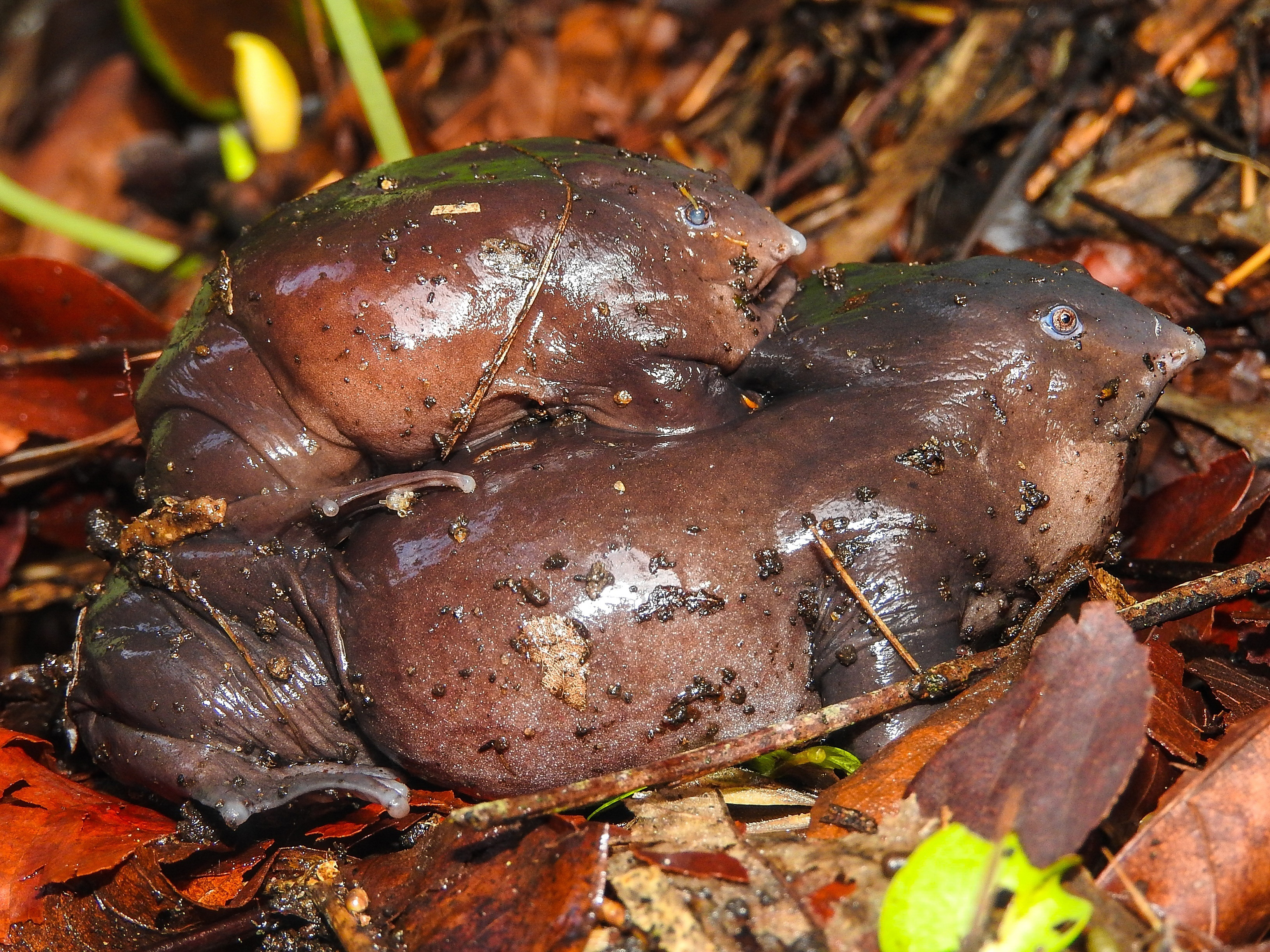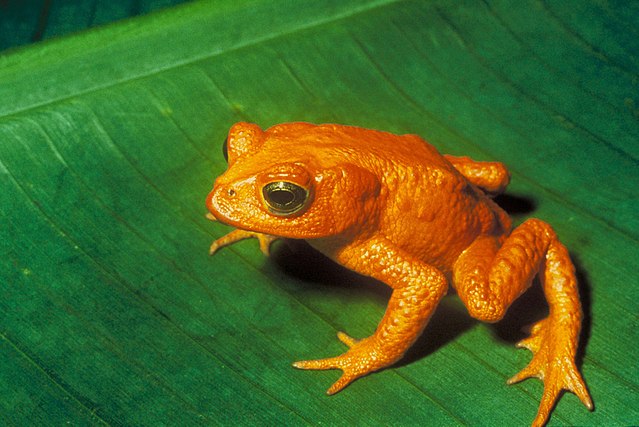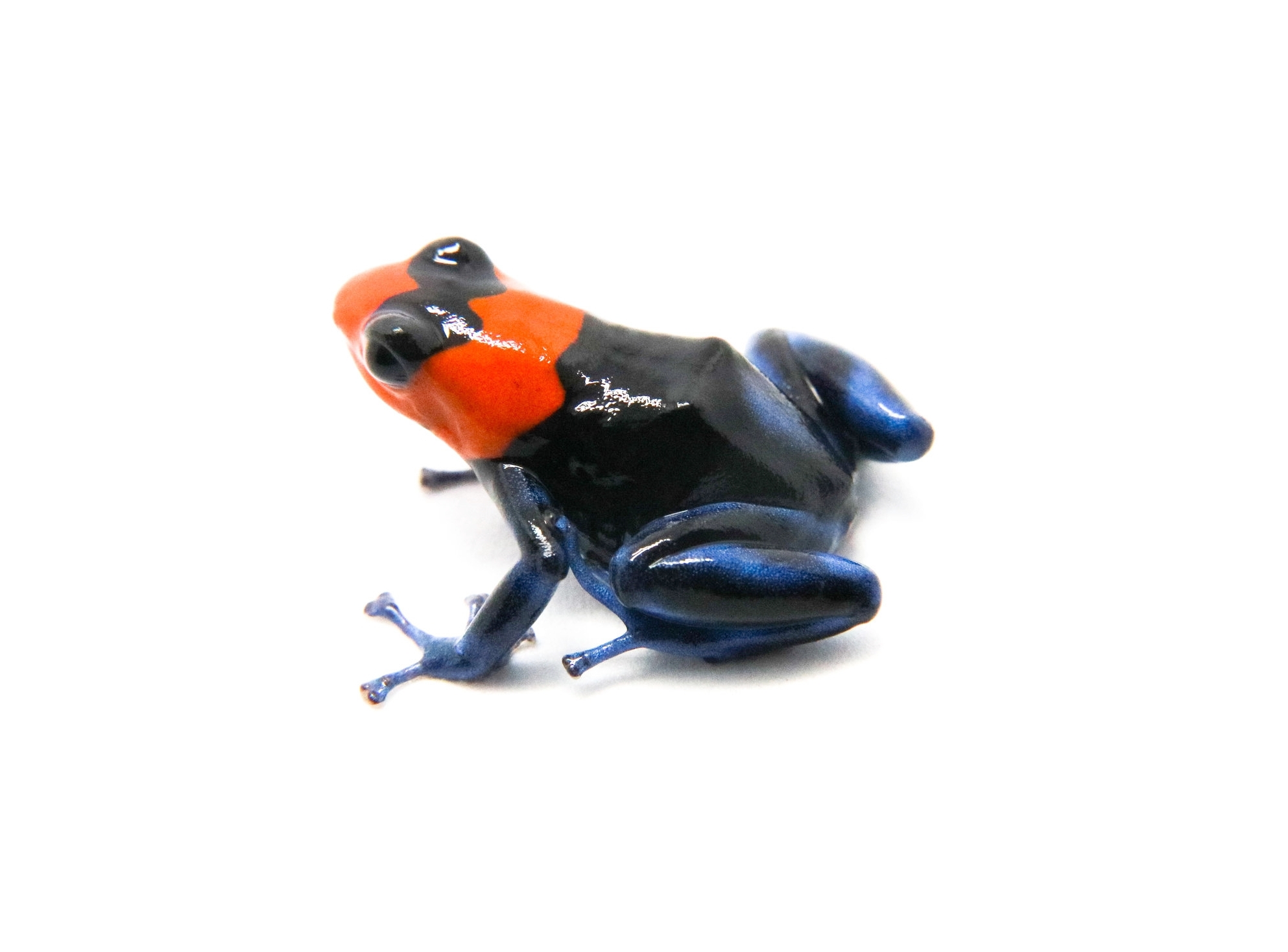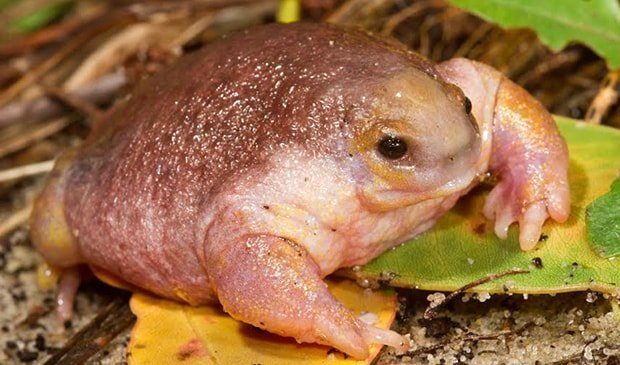As we speak, frogs and toads (interchangeable terms for various members of the order Anura) are experiencing massive population declines all around the world, with a majority of species on the road to extinction thanks to the deadly Chytrid fungus (spread world-wide by our own activities), habitat loss, climate shifts and more. While more common, hardier species are in little danger, many of the bizarre creatures we’re about to explore may be gone within our lifetimes, and some of them are already long gone. These hopping, leaping, sticky toed bug eaters can come in some surprising forms and possess even more surprising life cycles.
10.Vietnamese Mossy Frog
Theloderma corticale displays some of the most effective and elaborate camouflage in the amphibian world, its skin an irregular pattern of multicolored bumps and ridges resembling a large clump of lichen. To complete its disguise as inanimate vegetation, it tucks in its limbs and “plays dead” when startled. As you can see from photos, no two mossy frogs ever look exactly the same.
9. The Marsupial Frogs

Not content to leave abandon their tadpoles in a pond and hope for the best, frogs of the family Hemiphractidae are known for carrying their eggs and young on their backs, sometimes even protected within special sacs or pouches all the way through the tadpole stage.
8.The Surinam Toad
I’ve talked about Pipa pipa before for its bizarre child rearing habits, wherein the eggs are protected and hatched under excess flesh coating the female’s back, an adaptation many people may find disturbing to witness, so here’s a video! Hatching babies in their own skin isn’t the only thing that makes these frogs so unusual, of course. Flattened, mottled and gnarled, these creatures blend in perfectly with rotten leaves, using unique star-shaped sensory organs on their fingertips to detect passing prey. Completely aquatic, they are barely capable of movement on land.
7. The Purple Frog

Only officially discovered in 2003, Nasikabatrachus sahyadrensis is an Indian frog so unusual that it seems to have taken a completely different evolutionary route from most other Anura, much like the differences between the marsupials of Australia and placental mammals of other continents. Spending most of the year underground, the purple frog feeds on subterranean insects until it emerges for a massive mating frenzy during the brief seasonal monsoon.
6. The Golden Toad

You’re looking at one of only a handful of photographs ever taken of Bufo periglenes, the golden toad of Costa Rica, and one of the only photographs that ever will be taken, since the species met an abrupt extinction in the 1980’s. Only discovered in 1966, the golden toads still seemed safe in 1987 when a biologist counted over fifteen hundred of them mating in pools of rainwater. Only a year later, the same researcher found just a single, lonely male at the same site. Studies have blamed this sudden end on a combination of the Chytrid fungus and drier weather conditions brought about by El Niño. Those lucky enough to have seen the golden toads in person have described their colors as far more brilliant than any photograph could reproduce at the time. Only the males sported the solid golden orange, while the larger females were multicolored.
5.”Egg eating” Dart Frogs

Like all of the “dart” or “arrow” frogs, the vivid colors of the genus Oophaga are a warning sign to predators that their flesh packs an almost invariably fatal poison, though even the most venomous cold blooded animals have their sweet side – Males and females of this genus both engage in extensive parental care, and the “egg eating” is not what you might think. Females will lay only three to five fertile eggs after mating, and transport each individual tadpole (clinging to her back by a sucker) to its own separate pool of water, often in the cup-like base of a bromeliad plant. Mom will continuously make her rounds, checking up on each tadpole and laying unfertilized eggs in their pools as their primary food source. Males, meanwhile, are capable of carrying water in their cloacas (both the anal and reproductive opening) to keep eggs and larvae from drying out.
4. Turtle Frog

The only species in its unique genus, Australia’s Myobatrachus gouldii is even more divergent than the purple frog, having adapted to a mole-like existence of tunneling underground and breaking into termite nests, poking their comically small heads into the bug’s burrows and slurping them up. Rather than reproducing in water like a majority of other Anura, turtle frogs breed in their burrows and young skip past the tadpole phase, remaining in their eggs until they’ve formed into pin-headed burrowers themselves.
3. The Gastric Brooding Frog

Another one that has to end on a sad note, genus Rheobatrachus included only two species native to a small part of Eastern Australia, disappearing from our world in the same decade as the golden toad. Anatomically unusual for Australian frogs in almost every way, the two species seemingly evolved along their own unique path from any other known amphibians, having developed breeding practices observed nowhere else in nature. For up to six weeks, a female gastric brooding frog would carry her eggs and tadpoles directly in her stomach, her digestive functions and feeding behavior ceasing and her lungs even shrinking to accommodate her stomach’s rapid expansion. Releasing the young frogs was a gradual process often spaced out over many days, though in the case of sudden predator attack, she could essentially projectile vomit all her little ones in a last desperate effort to save their lives. The exact cause of their extinction is still uncertain.
2. The Hairy Frog
Trichobatrachus robustus is so named for a unique growth of hair-like filaments developed by males only during the breeding season. Filled with tiny blood vessels, these “hairs” are thought to aid the male in extracting oxygen from the water, as he will spend long periods of time protecting the submerged eggs. This alone is fairly unusual, but the species has possesses a rather gruesome defensive adaptation observed nowhere else in the animal kingdom; when grasped by some other animal, the frog essentially breaks the bones in its own toes and pushes them out through the skin, exposing sharpened points suitable for use as tiny claws. Like the equally hairy Wolverine, these “claws” eventually draw back inside and are quickly healed over.
1. The Giant Prehistoric Devil Toad

While Tyrannosaurus rex was chomping the bones of behemoths in the late Cretaceous period, another massive predator was terrorizing the swamps and marshes of what is now Madagascar. At sixteen terrifying inches in length, the humorously named Beelzebufo ampinga (derived from “Beelzebub,” a name sometimes attributed to satan, and “bufo” or “toad”) was larger than any frog or toad alive today, though otherwise similar to modern members of Ceratophryinae, the horned or “pac-man” frogs. Like its living relatives, Beelzebufo had tiny, bony projections in its upper jaw functioning as teeth, and likely sat motionless along muddy, mossy banks until oblivious prey wandered too close…prey that could have easily included tiny, recently hatched dinosaurs.

1 Comment
Informative list. I would love to see the prehistoric frog.